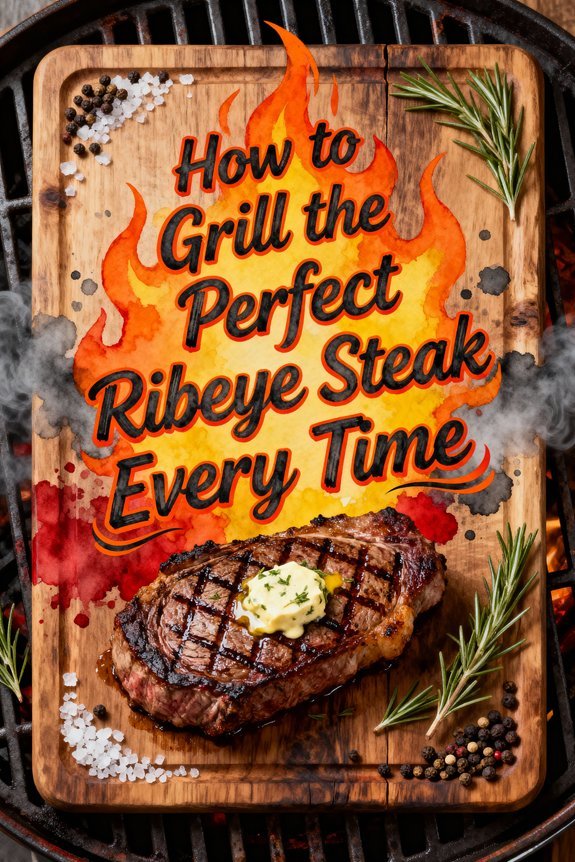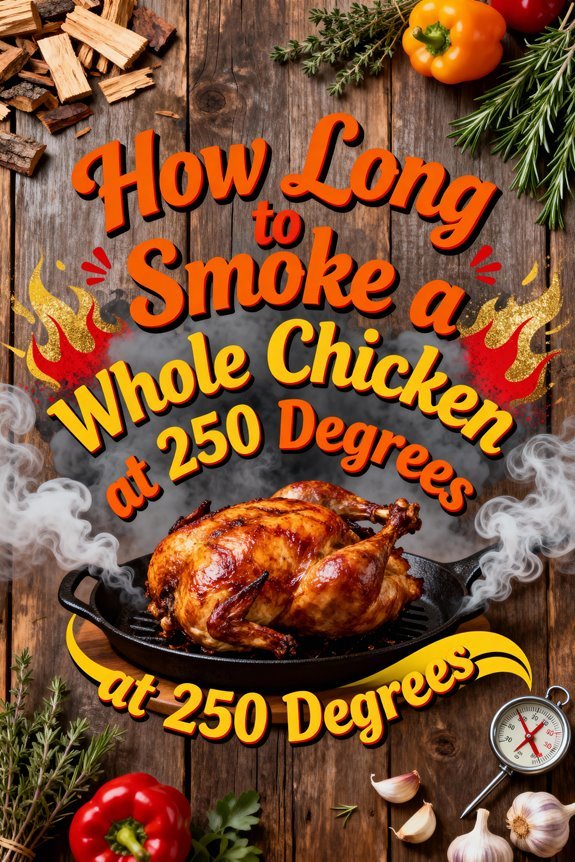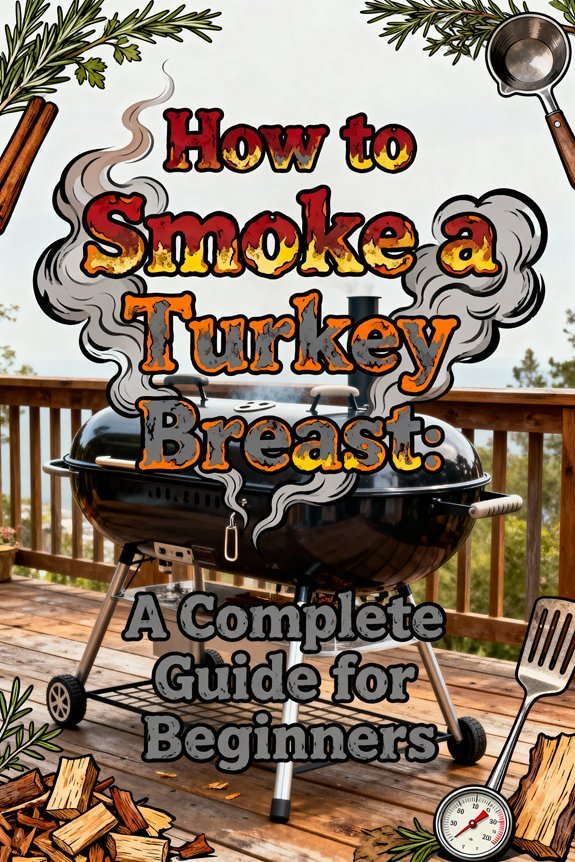To grill the perfect NY Strip, start with a USDA Prime cut that’s 1-1.5 inches thick and bring it to room temperature. Pat the steak dry, season with kosher salt and freshly ground pepper, then oil lightly. Preheat your grill to 500°F+ for direct heat searing. Grill 4-5 minutes per side for medium-rare (130-135°F internal), then rest for 10 minutes before slicing against the grain. Mastering these fundamentals reveals steakhouse-quality results at home.
Selecting the Right NY Strip Cut
Anyone can cook a great NY strip with the right cut selection. Look for steaks with bright cherry-red coloring and white (not yellow) fat, featuring consistent marbling throughout the meat. When examining cut quality, verify the steak measures 1-1.5 inches thick and weighs 8-12 ounces for ideal grilling results. Dry aging steaks creates a deeper, richer flavor profile while naturally tenderizing the meat. Similar to cedar plank grilling, proper cut selection helps maintain moisture and tenderness during cooking. Using a meat thermometer ensures precise doneness monitoring just like when smoking fish.
For superior marbling differences, choose USDA Prime grade, which offers the most intramuscular fat and guaranteed tenderness. If Prime isn’t available, Select Choice grade as your next best option. Ask your butcher to trim excess external fat while maintaining the characteristic strip of fat along one edge. Confirm your steaks have uniform thickness to prevent uneven cooking, and avoid cuts with long fat tails or minimal internal fat webbing.
Essential Pre-Grilling Preparation
Before firing up your grill, proper preparation of your NY strip steak is essential for achieving steakhouse-quality results. Remove your steak from the refrigerator about an hour before grilling to reach room temperature, guaranteeing even cooking throughout. For ideal moisture control, pat the meat dry with paper towels to promote better crust development. You can safely take the steak out up to four hours early to ensure it reaches the perfect temperature.
Apply dry brining techniques by coating your steak generously with kosher salt and letting it rest in the refrigerator. This process enhances tenderness and flavor while improving surface texture. Just before grilling, add freshly ground black pepper and a light coating of oil to prevent sticking. Similar to grilling chicken tenders at medium-high heat, you’ll want your grill preheated properly for the best results. Using an instant-read thermometer is crucial for achieving your desired level of doneness. Have your thermometer and tongs ready, and make certain your grill is clean and well-oiled. These preparation steps will set the foundation for perfectly grilled NY strip steak.
Setting Up Your Grill for Success
Three key elements define successful NY strip steak grilling: proper temperature control, strategic heat zone setup, and precise monitoring capabilities. For ideal results, you’ll need to configure your grill’s temperature zones correctly, regardless of grill types. Begin by preheating to 900°F for searing capability while establishing a two-zone fire setup. Using hardwood pellets can add delicious smoky flavors to your steak when grilling at lower temperatures. On charcoal grills, stack your coals on one side, leaving the other clear for indirect cooking at 300-325°F. With gas grills, adjust your burners to create distinct direct and indirect heat areas. Whether using a traditional grill or a wood pellet grill made overseas, proper heat management remains essential. Oil your clean grates lightly to prevent sticking, and confirm you’ve got a reliable digital thermometer ready. You’ll want to maintain the direct heat side above 500°F for proper searing, while keeping the lid closed to trap heat and promote even cooking. The reverse sear technique is particularly effective for steaks thicker than 1.5 inches to ensure even cooking throughout.
Mastering the Grilling Technique
With your grill properly configured, mastering the grilling technique for NY strip steak requires precise preparation and timing. First, bring your steak to room temperature and pat it dry. Apply a thin coat of olive oil and season generously with kosher salt. Consider dry brining for enhanced flavor.
When you’re ready to grill, preheat to 425-900°F and oil the grates. Place your steak over direct heat, closing the lid between flips. You’ll achieve excellent results using either the frequent-flip method (every 30 seconds) or the traditional single-flip approach. For precise doneness, use a digital thermometer to monitor internal temperature, aiming for 130-135°F for medium-rare. Remove the steak 5 degrees below target temperature, allowing carryover cooking during rest. Unlike complex sauce options, a simple compound butter during resting enhances the steak’s natural flavors. For optimal grilling results, select steaks with good marbling from your local butcher. After grilling, let the meat rest for 10-minutes to ensure the juices redistribute evenly throughout the steak. The reverse searing method can produce exceptional results by starting with low heat and finishing with a high-temperature sear.
Understanding Temperature and Doneness
Mastering steak doneness requires a thorough understanding of temperature ranges and their effects on meat texture. For your NY strip, you’ll need to take into account temperature effects that range from rare (120-130°F) to well-done (155°F+). The most popular doneness preferences fall in the medium-rare range (130-135°F), where you’ll achieve ideal tenderness and moisture retention. Since steaks cook from outside in, monitoring the exterior browning while checking internal temperature is crucial for optimal results. The reverse sear method allows precise temperature control by smoking at 225°F before finishing with high-heat searing.
Using a reliable meat thermometer, insert the probe into the thickest part of your NY strip to gauge doneness accurately. Remember that carryover cooking will raise the temperature by about 5°F during resting. For food safety, the USDA recommends a minimum internal temperature of 145°F, though many prefer their strips at lower temperatures. Always factor in your steak’s thickness, as this affects cooking time and temperature distribution. Like slow-cooked brisket, maintaining a consistent temperature range throughout the cooking process is essential for achieving the best results.
Resting and Finishing Touches
After your NY strip reaches the target temperature, proper resting becomes essential for achieving steakhouse-quality results. For your 1.5-inch thick strip steak, rest it for 5-7 minutes on a warm plate, lightly tented with foil. During this time, the internal temperature will rise 3-5°F through carryover cooking while the muscle fibers reabsorb the juices for ideal tenderness. Cutting too soon will cause precious juices to pool on your plate rather than staying in the meat. Just like with bone-in chicken, resting allows the meat’s internal juices to redistribute evenly throughout. Similar to checking that internal temperature reaches 165°F for poultry safety, monitoring your steak’s temperature ensures perfect doneness.
Once rested, apply your finishing touches. Brush the steak with a light coating of finishing oil or butter for enhanced sheen and flavor. Sprinkle with flaky finishing salt, then slice against the grain for maximum tenderness. For an optional professional touch, you can briefly return the steak to high heat for a final sear to refresh the crust before serving.
Serving and Pairing Suggestions
A perfectly grilled NY strip steak deserves thoughtful accompaniments that elevate its rich, beefy profile. For ideal side dishes, consider classic options like garlic mashed potatoes or creamed spinach, which provide creamy textures that complement the meat’s robustness. Roasted vegetables with herbs or sautéed mushrooms add essential freshness and earthiness to your plate. For a summer side dish, try grilled zucchini planks that cook evenly and develop beautiful char marks. These delightful combinations reflect our mission of bringing people together through memorable meals. For optimal tenderness, let your steak rest after cooking before slicing and serving.
Top your steak with a luxurious mushroom wine sauce or melted blue cheese for added depth. For perfect wine pairings, reach for a full-bodied Cabernet Sauvignon or Malbec that’ll enhance the beef’s natural flavors. If you’re crafting a steak sandwich, layer it on toasted ciabatta with caramelized onions and a garlic aioli. Don’t forget to serve sparkling water between bites to cleanse your palate.







